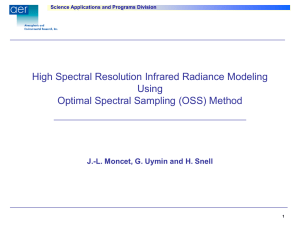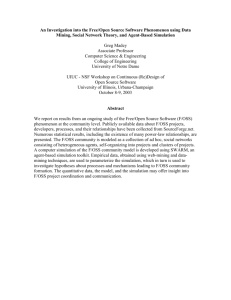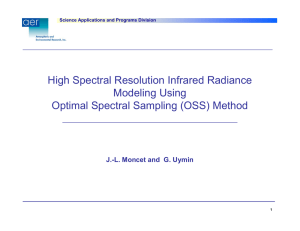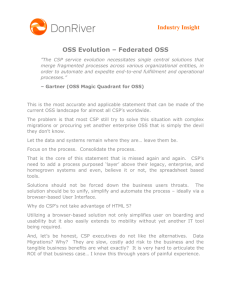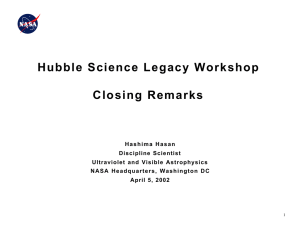High Spectral Resolution Infrared Radiance Modeling Using Optimal Spectral Sampling (OSS) Method
advertisement
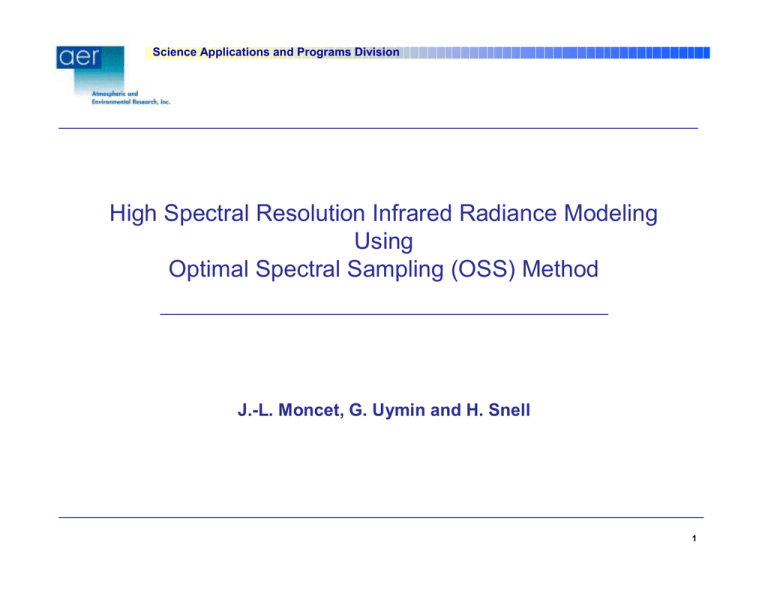
Science Applications and Programs Division
High Spectral Resolution Infrared Radiance Modeling
Using
Optimal Spectral Sampling (OSS) Method
J.-L. Moncet, G. Uymin and H. Snell
1
Science Applications and Programs Division
Parameterization of radiative transfer equation is
necessary for operational remote sensing
z
A class of techniques widely used in space-based remote sensing based on
McMillin and Fleming (1975) parameterizes the “effective layer optical depth”
for molecule m with profile-dependent predictors
τ (p )
ln m l = ∑ ail X ilm
τ (pl −1 ) i =1
m
–
z
τ m (pl ) = ∫ φν τ νm (pl )dν
N
(
{(
∆ν
)
X ilm θ scan , pi , Ti , qim ; i = 1,.., l
})
Very efficient for radiance calculations, and the accuracy is generally better than the
sensor noise level
Among the shortcomings of this method:
–
–
–
–
–
Not practical for use with changing observer altitude (e.g., airborne remote sensing)
Not amenable to multiple scattering atmospheres (e.g., cloud ice water path retrieval
from sub-millimeter measurements)
Inefficient computation of Jacobians
Accuracy depends on choice of predictors
Generally determined by trial and error and depend on the type of application
(viewing geometry, spectral band)
Not directly applicable to sinc function
2
Science Applications and Programs Division
OSS technique addresses the need for algorithm
speed, accuracy and flexibility
z
Model must be applicable to a wide-range of remote sensing platforms
–
–
–
–
z
Ideal model has consistent physics throughout
–
–
z
Microwave to visible
Narrow-band and wide band applications
Both accuracy and speed are important
–
z
Downlooking (satellite sensors)
Uplooking (ground-based sensors)
Aircraft or balloon (up or down looking with variable altitude range)
Limb and line-of-sight
Trade-off between accuracy and speed depending on the specifics of the
problem at hand
Sensor noise level
Science-grade versus operational code
Algorithm capable of calculating Jacobians necessary for inversion
–
Able to consider any number of “fixed” or “variable” molecular species and
geophysical parameters
3
Science Applications and Programs Division
OSS technique derived from ESFT and k-distribution
methods
z
Assumption
breaks down for
single absorber in
the presence of
lines of different
strengths or nonregularly spaced
lines
The exponential sum fitting (ESFT) and k-distribution methods
approximate band transmittances in homogenous atmospheres as,
N
τ (u ) = ∑ wi e − k u
i
i =1
z
Weights wi can be interpreted in terms of the probability
distribution of the absorption coefficient over the spectral interval
wi = ∆g i =
k i′
∫ p(k )dk
(k i′−1 < k i′ )
k i′−1
No satisfactory
treatment of
overlapping
absorbers when
relative
abundance of
individual species
changes with
altitude
and ki is a representative k-value for the interval
z
z
[k i′−1 , k i′]
Extension of this k-distribution method to non-homogeneous
atmospheres is based on observation that minima and maxima of
absorption in different layers coincide spectrally
Correlated-k method vertically integrates RT equation by assuming
a correspondence between k’s in g-space in different layers, i.e.
minimal impact on results of re-arranging kQ by ascending order in
individual layers
4
Science Applications and Programs Division
OSS selects the frequencies and absorption
coefficients relevant to the calculation of radiance
z
Proper treatment of overlapping absorbers requires accurate
characterization of the multivariate probability distribution of absorption
coefficients for all layers and molecules
z
High dimensionality of the problem makes it impractical to attempt to solve
directly for the k ’s without appropriate constraints
z
OSS solution
–
–
–
Reduce the problem to a one-dimensional frequency search
Require that the k ’s correspond to actual values of absorption coefficient for all
molecules and layers at the selected frequencies
Patent pending
5
Science Applications and Programs Division
OSS parameters generated from monochromatic
calculations
z
Weights
computed by
linear
regression for
each trial
combination
of frequencies
Radiative
transfer
accuracy and
computation
time
requirements
must be
considered
when
selecting error
threshold
Parameter generation starts from a set of uniformly spaced
monochromatic transmittances (or radiances)
–
–
z
Compute with a line-by-line model (e.g. LBLRTM)
Use a globally representative ensemble (S) of atmospheres
Search for the smallest subset of frequencies (nodes) and
associated weights for which the error is less than a prescribed
tolerance for all levels
(
)
w
i
=
N
ν
,
1
,..,
i i
ε N = ∑ τ s (pl ) − ∑ wiτ νs (pl )
s
i =1
N
2
i
(search method described below)
6
Science Applications and Programs Division
Flow diagram for OSS parameter generation
Atmospheric
training set
Reference
line-by-line
model
Monochromatic transmittances
(uniform spectral grid)
Convolve with
instrument function
Instrument Function
Output selected
wavenumbers and
associated weights
Node selection
{τν, i}
Weight computation
weights and fitting error
OSS parameter generation
7
Science Applications and Programs Division
Model “training” done in terms of radiance and
includes appropriate scene variability
Line-by-line
calculation
has largest
impact on
computation
time
requirements,
not the search
time
Scene
stratification
generally
reduces the
size of the
OSS
parameter file
z
Set of training scenes includes appropriate variability
–
–
–
–
z
Viewing angle
Surface emissivity and reflectivity
Observer altitude
Solar angles
Fit is done in radiances (or brightness temperatures), which is
equivalent to weighting the transmittances at each level by the
channel weighting function
s N
ε N = ∑ r − ∑ wi rνsi
s
i =1
z
2
Scene stratification ensures model accuracy (threshold rms) is
maintained for a larger set of conditions
–
–
“Global” ensemble includes all viewing angles, a wide range of
atmospheric profiles, and the full range of surface emissivity
Stratified selection can be done for a subset of conditions (e.g. one view
angle)
8
Science Applications and Programs Division
Example of OSS selection shows exploitation of
redundant information
Smaller
threshold
results in
larger number
of selected
points
Redundant
spectral
information
utilized only to
the extent
needed to
meet
threshold
requirement
9
Science Applications and Programs Division
Species transmittance accuracy contributes only a
small part of the overall radiance error
Total
O3
H2O
CO2
10
Science Applications and Programs Division
Examination of Jacobians illustrates the technique
works well for both the forward and inverse problem
11
Science Applications and Programs Division
Automated process for sequential search based on
Wiscombe and Evans (1977)
z
z
–
–
z
Find {ν1,w1} such that
εn (n=1) is minimized
The procedure consists of starting with N=1
and searching for the spectral location that
produces the smallest error among the M
possible locations
Once Q1 and its associated weight have been
determined, the fitting error is compared to
the prescribed tolerance
If H1 < H tol the procedure stops. Otherwise, N is
incremented by one and the search for Q2
proceeds in the same fashion
Weights are reevaluated for each trial
combination of nodes
Weights are constrained (sum is 1.0 and all
weights positive)
–
Set n=n+1
Pairs of nodes with almost identical absorption
characteristics results in ill-conditioned
solution (large negative weights)
Occurs most often with large number of nodes
(search is on the wrong “path”)
Negative node eliminated and search restarted
using remaining weights
Find new node, νn, and
optimal set of weights {wi;
i=1,..,n }
such that εn is minimized
no
all wi’s > 0?
no
Drop negative node with
smallest index, i, and
replace with last selected
node, νn.
yes
εn < εtol ?
yes
End
12
Science Applications and Programs Division
Monte-Carlo search has advantages over other
search techniques
z
With any
method it is
best to start
training on a
small interval
and increase
progressively
until sensor
resolution is
achieved
Random search can be slow due to non-unique solution
–
–
z
Sequential search approach is faster than random search
–
–
z
Many combinations of nodes produce similar performance
Computational issues dominate with moderate number of candidates
100 points at 0.0001 cm-1 implies 0.01 cm-1 channel
Non-optimal when number of nodes approaches or exceeds 10
Not applicable to non-positive instrument functions (e.g., non-apodized
interferometer ILS)
Monte-Carlo approach replaces a selected node by one randomly
chosen from remaining candidates
–
–
Acceptance depends on difference in rms errors
Number of replacements is restricted
Pre-defined based on based on selected nodes and total available
Acceptance test adjusted if acceptance rate is low
13
Science Applications and Programs Division
Use a subset of the sounding bands to examine OSS
node selection properties
z
z
z
z
z
z
Spectral region: 650-850 cm-1 (CO2 band)
Variable species: water vapor and ozone
Surface emissivity set to unity
Training set: AIRS/UMBC 48 profile set
5 scan angles with corresponding secant = 0, 0.5, 1, 1.5 and 2
Reference line-by line model: LBLRTM
14
Science Applications and Programs Division
Training profiles provided by UMBC
(AIRS profile set)
15
Science Applications and Programs Division
Examination of brightness temperature differences
illustrates impact of H2O and O3 in the CO2 band
Expect more
selection
nodes in
regions where
there are
overlapping
gases
16
Science Applications and Programs Division
Number of selected nodes varies depending on
number of atmospheric gases considered
Spectral
resolution has
minimal
impact on
number of
nodes
17
Science Applications and Programs Division
Number of selected nodes increases as accuracy
threshold decreases
Larger
increase in
number of
points where
gases overlap
18
Science Applications and Programs Division
Number of selected nodes depends on accuracy,
resolution, and spectrum complexity
N3 points
required for
gases with
totally
independent
contributions
(27 for three
gases)
19
Science Applications and Programs Division
OSS has been applied to an “boxcar” instrument
z
z
Three spectral bands: 600-1100 cm-1, 1200-1750 cm-1 and 2150-2700 cm-1
Boxcar instrument function
–
z
z
Width: 1.25 cm-1, 2.5 cm-1 and 5 cm-1
Selection accuracy of 0.05K in brightness temperature
Nadir only
20
Science Applications and Programs Division
Model accuracy is very good when compared with
independent set of profiles
Train: UMBC
Validate: TIGR
Errors are due
ONLY to OSS
sampling (no
optical depth
or radiative
transfer
errors)
21
Science Applications and Programs Division
OSS-based radiative transfer model developed for
sensor simulation and retrieval studies
z
Model used for
retrieval
algorithm
development
and to assess
operational
capabilities
z
z
Radiative transfer is performed monochromatically from precomputed absorption coefficients (at each selected node) for the
fixed and variables constituents
Gases are grouped into fixed (e.g. CO2, CO and CFC’s) and
variable category (e.g. H2O, O3, CH4, N2O)
Absorption coefficients are stored in each layer as a function of
temperature
–
z
Absorption properties are linearly interpolated between temperature
entries to preserve computational efficiency
Water vapor requires special treatment for self-broadening effect
–
–
Total (self and foreign broadened) water vapor absorption coefficient
(in cm2/molecule) is stored as a function of both temperature and
water vapor (takes into account self-broadening effects in the near
wings; important for up-looking)
Approximately linear in specific humidity or partial pressure (i.e. two
points are sufficient)
22
Science Applications and Programs Division
Main strength of the OSS approach is the analytical
computation of the Jacobians
z
z
For an average of 4.5 nodes/channel (0.05K accuracy), OSS model should
be roughly two times slower than current fast models for AIRS
Jacobian computation normally requires of the order of (m+1)L2
operations for computation of transmittance and radiance derivatives
(from ∂τ l ∂X k )
∂R ∂X k = − ∂Τk +1 ∂X k Bk +
L
∑ (∂Τ
l = k +1
l
∂X k − ∂Τl +1 ∂X k )Bl + ∂ΤL ∂X k Bs
∂Τl ∂X k = τ l ∂Τl −1 ∂X k + Τl −1 ∂τ l ∂X k
z
With monochromatic RT, Jacobian computation reduces to
∂R ∂X k = ∂τ k ∂X k Dk
where
L
Dk = Bk − ∑ (Τl − Τl +1 )Bl − ΤL Bs
l = k +1
is independent of X and is derived in the process of adding layers
successively during radiance computation
23
Science Applications and Programs Division
Minimal computational penalty for calculation of
radiance derivatives
z
Full calculation
of derivatives
only doubles
the number of
operations
OD
RT
Total
Average number of operations per channel and per layer
–
–
–
–
No derivative case: optical depth and radiance calculation only
Temperature derivatives only: don’t consider change of W with T
Molecular derivatives and temperature derivatives
All derivatives, including temperature dependence of molecular
absorption
No Drv
33.42
30.25
63.67
Dr/Dt
33.42
50.15
83.57
Dr/Dq
33.42
64.78
98.20
Dr/Dt+
47.89
69.25
117.15
24
Science Applications and Programs Division
Direct application to Fourier interferometer (nonlocalized instrument function)
z
OSS model is
directly
applicable to
non-apodized
instrument
functions
z
Barnett (2000) and McMillin (2000) have devised approaches to
extend application of narrow band models to sinc functions
Extended instrument functions can present problems for model
training
–
–
z
Instrument function is not positive, and negative weights cannot be used
to indicate the presence of close pairs (or ill-conditioning)
Fix for OSS: use determinant control
Planck function and surface emissivity vary over the wavenumber span
of the sinc function
Center frequency approximation used for localized instrument
functions is non longer valid
Fix for OSS: use additional parameters for training
– Accuracy may be enhanced by scene stratification
Overlapping node points exploited in radiative transfer calculation
–
–
Using the same selection points for multiple channels reduces the
overall number of radiative transfer calculations (application of channel
weights requires minimal amount of computation time)
Duplication range of about 50% is typical
25
Science Applications and Programs Division
Number of selected nodes increases for nonlocalized instrument function (nadir-only case)
Must consider
total number
of
independent
points
selected, not
total number
of selected
nodes for each
channel
26
Science Applications and Programs Division
Examination of widely-spaced sinc functions
illustrates redundant node selection
27
Science Applications and Programs Division
OSS selection performs very well for sinc function
Train: UMBC
Validate: TIGR
Errors are due
ONLY to OSS
sampling (no
optical depth
or radiative
transfer
errors)
28
Science Applications and Programs Division
OSS technique addresses the need for algorithm
speed, accuracy and flexibility
z
OSS generation process is automated and unsupervised
–
z
The method is robust with respect to training
–
z
Accurate treatment of surface reflection
Amenable to multiple scattering applications
Flexible for use with varying observer levels or viewing geometries
Model is both fast (especially when Jacobians are required) and
accurate
–
z
Scene stratification improves performance over range of scene types
Radiative transfer is monochromatic:
–
–
–
z
No tuning needed; no check for instabilities; able to adapt quickly to
changes in the instrument function or to update spectroscopy
Accuracy can be traded for speed depending on the sensor noise level
and computational requirements of the problem
On-going development at AER for range of applications
–
–
–
–
NPOESS CrIS (IR) and CMIS (microwave)
NAST-I (IR)
AIRS (IR)
Naval Post-Graduate School (microwave – visible)
29
